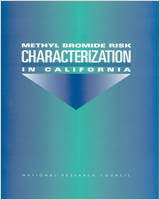NCBI Bookshelf. A service of the National Library of Medicine, National Institutes of Health.
National Research Council (US) Subcommittee for the Review of the Risk Assessment of Methyl Bromide. Methyl Bromide Risk Characterization in California. Washington (DC): National Academies Press (US); 2000.

Methyl Bromide Risk Characterization in California.
Show detailsOne of the most widely used pesticides in California is methyl bromide, a gaseous fumigant that is used on a variety of crops primarily as a preplant soil insecticide, on post-harvest commodities, and in some residences as a fumigant. Although methyl bromide is a recognized stratospheric ozone depleter and is scheduled to be phased out completely by 2005 under the United Nations Montreal Protocol, it continues to be of concern for the health of agricultural workers and exposed residents.
The California Department of Pesticide Regulation (DPR) is responsible for the development of regulations that determine the site-specific permit conditions for the application of pesticides in the state. California is currently in the process of proposing new regulations for issuing methyl bromide permits that require submission of a worksite plan by the property operator, provide extra protection for children in nearby schools, establish minimum buffer zones around application sites, require that nearby residents receive prior notification of the application of methyl bromide, and set new limits on hours that fumigation employees may work. To develop these regulations, the DPR prepared a risk-characterization document to evaluate the toxicity and exposure potential for workers and residents resulting from the inhalation of this pesticide.
Under Section 57004 of the California Health and Safety Code, the scientific basis of the proposed regulations is subject to external peer review by the National Academy of Sciences, the University of California, or other similar institution of higher learning or group of scientists. This report addresses that regulatory requirement by reviewing the DPR risk-characterization document that supports the proposed regulations.
The National Research Council (NRC), the operating arm of The National Academies, assigned the task of preparing this report to its Committee on Toxicology, which convened the subcommittee for the review of the risk assessment of methyl bromide. The subcommittee was charged with the following tasks: (1) determine whether all relevant data were considered, (2) determine the appropriateness of the critical studies and endpoints used in the risk assessment and in the derivation of exposure limits, (3) consider the mode of action of methyl bromide and its implications in risk assessment, and (4) determine the appropriateness of the exposure assessment and mathematical models used. The subcommittee also identified data gaps and made recommendations for further research relevant to setting exposure limits for methyl bromide.
To prepare this report, the subcommittee reviewed the materials supplied by DPR, additional supporting materials received from other individuals and organizations, and the information gathered at a public meeting held in Irvine, California, on October 4, 1999. The subcommittee wishes to thank the following members of the California Department of Pesticide Regulation—Paul Gosselin, Acting Chief Deputy Director, Lori Lim, and Thomas Thongsinthusak—for providing the subcommittee with information on methyl bromide toxicology and exposure data and models, for their presentation at the public meeting, and for responding to follow up requests from the subcommittee members. We also gratefully acknowledge Vincent J.Piccirillo, NPC, Inc., Bill Walker, Environmental Working Group, and Amy Kyle, Consulting Scientist, for providing background information and for making presentations to the subcommittee, and Jodi Kuhn, Methyl Bromide Industry Panel of the Chemical Manufacturers Association, for providing background materials as well.
This report has been reviewed in draft form by individuals chosen for their diverse perspectives and technical expertise, in accordance with procedures for reviewing NRC reports approved by the NRC's Report Review Committee. The purpose of this independent review is to provide candid and critical comments that will assist NRC in making the published report as sound as possible and to ensure that the report meets institutional standards for objectivity, evidence, and responsiveness to the study charge. The content of the final report is the responsibility of NRC and the study subcommittee, and not the responsibility of the reviewers. The review comments and draft manuscript remain confidential to protect the integrity of the deliberative process. We wish to thank the following individuals, who are neither officials nor employees of NRC, for their participation in the review of the report: Dana Barr, Centers for Disease Control and Prevention; David Dorman, Chemical Industry Institute of Toxicology; David Gaylor, National Center for Toxicological Research; Craig Harris, University of Michigan; John Morris, University of Connecticut; and P.Barry Ryan, Emory University. These reviewers have provided many constructive comments and suggestions; it must be emphasized, however, that responsibility for the final content of this report rests entirely with the authoring subcommittee and NRC.
I am also grateful for the assistance of NRC staff in the preparation of this report. In particular, the subcommittee wishes to acknowledge Roberta Wedge, staff officer for the subcommittee, and Eileen Abt, research associate, with the Board on Environmental Studies and Toxicology. Other staff members who contributed to this effort are Robert Crossgrove, editor, Lucy Fusco, project assistant, and Kulbir Bakshi, program director for the Committee on Toxicology.
Finally, I would like to thank the members of the subcommittee for their valuable expertise and dedicated efforts throughout the preparation of this report. Their efforts are much appreciated.
Charles H.Hobbs, D.V.M.
Chair, Subcommittee on the Review of the Risk Assessment for Methyl Bromide
- Preface - Methyl Bromide Risk Characterization in CaliforniaPreface - Methyl Bromide Risk Characterization in California
Your browsing activity is empty.
Activity recording is turned off.
See more...